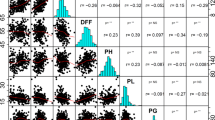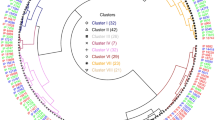Abstract
Pearl millet contributes to the major source of dietary calories and essential micronutrients intake among rural populations in certain regions of India as its grains are more nutritious than other cereals. The aims of this investigation were to profile cultivar nutrition, diversity and interrelationship for grain minerals (Ca, K, Mg, Na, P, S, Cu, Fe, Mn, Zn, Mo and Ni) among 122 pearl millet hybrids and open-pollinated varieties in India. Trials were evaluated in randomized complete block design with three replications at two locations (Patancheru and Mandor) representing two major cultivation zones. The grain minerals in cultivars exhibited two- to- four-fold variation. Positive and significant correlations were noted among different minerals. A higher magnitude of positive and significant association between Fe and Zn (r = 0.71, P < 0.01) and with other minerals suggested the existence of greater genetic potential for the concurrent improvement of Fe and Zn without lowering the other grain minerals in pearl millet. The first two principal components accounted for 49% of variation. Euclidian distance-based cluster analysis grouped the 122 cultivars into seven clusters. Cluster I had higher mean for Fe (56 mg kg−1) and Zn (49 mg kg−1), in which ICTP 8203, Ajeet 38, Sanjivani 222, PAC 903 and 86 M 86 were identified as rich sources of iron, zinc and calcium with considerable levels of other nutrients. About 65% of cultivars for iron and 100% of cultivars for zinc have met the minimum standards set forth by the Indian Council of Agricultural Research. This indicates the feasibility of breeding nutrient-rich hybrids with competitive yields through mainstreaming in future.


Similar content being viewed by others
References
AIRCP on Pearl Millet - Report on the Project Coordinator Review (2019) 54th Annual Group Meeting. ICAR- Indian Agricultural Research Institute, New Delhi
Al-Fartusie FS, Mohssan SN (2017) Essential trace elements and their vital roles in human body. Indian J Adv Chem Sci 5:127–136
Andrews DJ, Anand Kumar K (1992) Pearl millet for food, feed and forage. Adv Agron 48:89–139
Anonymous (2013) Role of millets in nutritional security of India. Policy Paper Number 66, NAAS, New Delhi
Barbosa F, Claudivan F, Hans Raj G, Gabriel CF, Ricardo J Jr, Yara AL, Fernando FFH (2012) Yield and ion content in maize irrigated with saline water in a continuous or alternating system. Cienc Rural 42:10. https://doi.org/10.1590/S0103-84782012001000003
Brown IJ, Tzoulaki I, Candeias V, Elliott P (2009) Salt intakes around the world: implications for public health. Int J Epidemiol 38:791–813
Cakmak I, Pfeiffer WH, McClafferty B (2010) Review: biofortification of durum wheat with zinc and iron. Cereal Chem J 87:10–20
Chhipa BR, Lal P (1995) Na/K ratios as the basis of salt tolerance in wheat. Aust J Agric Res 46:533–539
Clausen MV, Hilbers F, Poulsen H (2017) The structure and function of the Na, K-ATPase isoforms in health and disease. Front Physiol 8:371
Epstein E (1985) Salt tolerant crops: origin, development and prospects of the concept. Plant Soil 89:87–198
FAO/WHO (2000) Preliminary report on recommended nutrient intakes. Joint FAO/WHO Expert Consultation on Human Vitamin and Mineral Requirements, FAO, Bangkok, Thailand, Sept 21–30, 1998, Food and Agricultural Organization of the United Nations and World Health Organization, Geneva, Switzerland
Gomez KA, Gomez AA (1984) Statistical procedures for agricultural research, 2nd edn. Wiley, NewYork, p 680
Govindaraj M, Rai KN, Shanmugasundaram P, Dwivedi SL, Sahrawat KL (2013) Combining ability and heterosis for grain iron and zinc densities in pearl millet. Crop Sci 53(2):507–517
Govindaraj M, Rai KN, Cherian B, Pfeiffer WH, Kanatti A, Shivade H (2019) Breeding biofortified pearl millet varieties and hybrids to enhance millet markets for human nutrition. Agriculture 9(5):106
Gyawali S, Otte ML, Jacob DL, Abderrazek J, Verma RPS (2019) Multiple element concentration in the grain of spring barley (Hordeum vulgare L.) collection. J Plant Nutr 42(9):1036–1046
Harvard Heart Letter (2011) Sodium/potassium ratio important for health. Issue: September, Harvard Health Publishing. https://www.health.harvard.edu/heart-health/sodiumpotassium-ratio-important-for-health. Accessed 15 July 2019
Holland SM (2008) Principal components analysis (PCA). Department of Geology, University of Georgia, Athens, pp 30602–32501
House WA, Van Campen DR, Welch RS (1996) Influence of dietary sulfur-containing amino acids on the bioavailability to rats of zinc in corn kernels. Nutr Res 16:225–235
Kanatti A, Rai KN, Radhika K, Govindaraj M, Sahrawat KL, Srinivasu K, Shivade H (2014) Relationship of grain iron and zinc content with grain yield in pearl millet hybrids. Crop Improv 41:91–96
Kanatti A, Rai KN, Radhika K, Govindaraj M, Sahrawat KL, Rao AS (2014) Grain iron and zinc density in pearl millet: combining ability, heterosis and association with grain yield and grain size. SpringerPlus 3:763
Karaköy T, Erdem H, Baloch FS, Toklu F, Eker S, Kilian B, Özkan H (2012) Diversity of macro- and micronutrients in the seeds of lentil landraces. Sci World J 201:9. https://doi.org/10.1100/2012/710412
Keuls M (1952) The use of the “studentized range” in connection with an analysis of variance. Euphytica 1(2):112–122. https://doi.org/10.1007/bf01908269
Kumar A, Tomar V, Kaur A, Kumar V, Gupta K (2018) Millets: a solution to agrarian and nutritional challenges. Agric Food Secur 7:31. https://doi.org/10.1186/s40066-018-0183-3
Linus Pauling Institute (2019) Micronutrient Information Center. Web page of Linus Pauling Institute. http://lpi.oregonstate.edu/infocenter/minerals/zinc/. Accessed 10 June 2019
Lum MS, Neoh WT (2018) Nutritional quality of rice variety in Sabah, Malaysia. Trans Sci Technol 5(2):88–92
Marcus JB (2013) Vitamin and mineral basics: the ABCs of healthy foods and beverages, including phytonutrients and functional foods: healthy vitamin and mineral choices, roles and applications in nutrition, food science and the culinary arts. ch. 7. Food Science and the Culinary Arts. In: Marcus JB (ed) Culinary nutrition: the science and practice of healthy cooking. Academic Press, Boca Raton, pp 279–331
Neeraja CN, Babu VR, Ram S, Hossain F, Hariprasanna K, Rajpurohit BS, Longvah PT, Prasad KS, Sandhu JS, Datta SK (2017) Biofortification in cereals: progress and prospects. Curr Sci 113:1050–1057
Newman D (1939) The distribution of range in samples from a normal population, expressed in terms of an independent estimate of standard deviation. Biometrika 31(1):20–30. https://doi.org/10.1093/biomet/31.1-2.20
Pandey A, Khan MK, Hakki EE, Thomas G, Hamurcu M, Gezgin S, Gizlenci O, Akkaya MS (2016) Assessment of genetic variability for grain nutrients from diverse regions: potential for wheat improvement. SpringerPlus 5:1912. https://doi.org/10.1186/s40064-016-3586-2
Parthasarathy Rao P, Birthal PS, Reddy BVS, Rai KN, Ramesh S (2006) Diagnostics of sorghum and pearl millet grain based nutrition in India. Int Sorghum Millets Newsl 46:93–96
Prasad R, Shivay YS, Kumar D (2014) Agronomic biofortification of cereal grains with iron and zinc. Adv Agron 125:55–91
R Core Team (2018) R: a language and environment for statistical computing. R Foundation for Statistical Computing, Vienna
Rai KN, Yadav OP, Govindraj M, Pfeiffer WH, Yadav HP, Rajpurohit BS, Patil HT, Kanatti A, Rathore A, Rao AS, Shivade H (2016) Grain iron and zinc densities in release and commercial cultivars of pearl millet. Indian J Agric Sci 86:291–296
Rao P, Venkata PK, Kumari T, Surya S, Mohan M, Venkata Rao S (2012) Genetic analysis of sodium content and Na/K ratio in relation to salinity tolerance in pearl millet (Pennisetum glaucum L. R Br). J Crop Sci Biotechnol 15:195–203
Ren ZH, Gao JP, Li LG, Cai XL, Huang W, Chao DY, Zhu MZ, Wang ZY, Luan S, Lin HX (2005) A rice quantitative trait locus for salt tolerance encodes a sodium transporter. Nat Genet 37:1141–1146. https://doi.org/10.1038/ng1643
Roger M (2011) The minerals you need, USA. Safe Goods Publishing, Sheffield, p 42
SAS Institute Inc. (2015) SAS/STAT® 14.1 user’s guide. SAS Institute Inc., Cary
Singh RK, Redoña E, Refuerzo L (2010) Varietal improvement for abiotic stress tolerance in crop plants: special reference to salinity in rice. In: Pareek A, Sopory SK, Bohnert HJ, Govindjee N (eds) Abiotic stress adaptation in plants: physiological, molecular and genomic foundation. Springer, Dordrecht, pp 387–415
Snedecor GW, Cochran WG (1989) Statistical methods, 8th edn. Iowa State University Press, Iowa
Stangoulis J, Sison C (2008) Crop sampling protocols for micronutrient analysis. HarvestPlus Technical Monograph Series 7, ISBN 978-0-9818176-0-6
Thomson MJ, de Ocampo M, Egdane J, Rahman MA, Sajise AG, Adorada DL et al (2010) Characterizing the Saltol quantitative trait locus for salinity tolerance in rice. Rice 3:148–160
Walia H, Wilson C, Condamine P, Liu X, Ismail AM, Zeng L et al (2005) Comparative transcriptional profiling of two contrasting rice genotypes under salinity stress during the vegetative growth stage. Plant Physiol 39:822–835. https://doi.org/10.1104/pp.105.065961
Ward JH (1963) Hierarchical grouping to optimize an objective function. J Am Stat Assoc 58:236–244
Welch RM, Graham RD (2004) Breeding for micronutrients in staple food crops from a human perspective. J Expt Bot 55:353–364
Wheal MS, Fowles TO, Palmer LT (2011) A cost-effective acid digestion method using closed polypropylene tubes for inductively coupled plasma optical emission spectrometry (ICP-OES) analysis of plant essential elements. Anal Methods 3:2854–2863
White PJ, Brown PH (2010) Plant nutrition for sustainable development and global health. Ann Bot 105:1073–1080
World Health Organisation (2003) Diet, nutrition and the prevention of chronic disease. World Health Organisation, Geneva
World Health Organization (2007) Reducing salt intake in populations. Report of a WHO forum and technical meeting, Paris, France
World Health Organization (2013) Global action plan for the prevention and control of non-communicable diseases 2013–2020. World Health Organization, Geneva
Yadav OP, Rai KN, Rajpurohit BS, Hash CT, Mahala RS, Gupta SK, Shetty HS, Bishnoi HR, Rathore MS, Kumar A, Sehgal S, Raghvani KL (2012) Twenty-five years of pearl millet improvement in India. All India Coordinated Pearl Millet Improvement Project, Jodhpur
Yadav OP, Rai KN, Yadav HP, Rajpurohit BS, Gupta SK, Rathore A, Karjagi CG (2016) Assessment of diversity in commercial hybrids of pearl millet in India. Indian J Plant Genet Resour 29(2):130–136. https://doi.org/10.5958/0976-1926.2016.00018.8
Acknowledgments
Authors thank the various research partner organizations for providing the seed and HarvestPlus Biofortfication program of the CGAIR for analysing the samples for nutrient profiling. This work was carried as part of the ICAR-ICRISAT colloborative Research Project and CRP on Agriculture for Nutrition and Health.
Author information
Authors and Affiliations
Corresponding author
Additional information
Publisher's Note
Springer Nature remains neutral with regard to jurisdictional claims in published maps and institutional affiliations.
Electronic supplementary material
Below is the link to the electronic supplementary material.
Rights and permissions
About this article
Cite this article
Govindaraj, M., Yadav, O.P., Rajpurohit, B.S. et al. Genetic Variability, Diversity and Interrelationship for Twelve Grain Minerals in 122 Commercial Pearl Millet Cultivars in India. Agric Res 9, 516–525 (2020). https://doi.org/10.1007/s40003-020-00470-7
Received:
Accepted:
Published:
Issue Date:
DOI: https://doi.org/10.1007/s40003-020-00470-7




